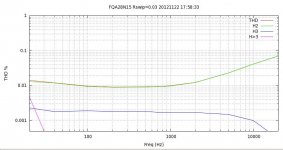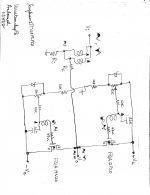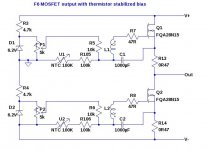so - having degeneration because of tempco , while not sacrificing xconductance
ZAP per personal choice
ZAP per personal choice
Rs=0R47 sounds about right for thermal stability.
Any reason not to use one or more "Zen pots"?
1.0 ohms would be even better, unless you use some temperature
compensation. The technique of F5 would be an example.
No reason not to use "Zen pots" - on one extreme, AC degeneration, on the
other extreme, my suggestion above.
Of course some laterals will solve the temperature coefficient issue, but will
have a lot lower transconductance. Still, they'll work fine - as I said earlier,
we have open loop gain to burn.
😎
EUVL and others have implemented F5s without thermistors with Rs as low as 0R22 and claim that they are thermally stable. I suppose it could also depend on the choice of MOSFET.
1.0 ohms would be even better, unless you use some temperature
compensation. The technique of F5 would be an example.
No reason not to use "Zen pots" - on one extreme, AC degeneration, on the
other extreme, my suggestion above.
Of course some laterals will solve the temperature coefficient issue, but will
have a lot lower transconductance. Still, they'll work fine - as I said earlier,
we have open loop gain to burn.
😎
The IRFP240's have a lower thermal coefficient than the Fairchild parts in the
F5, so that is plausible.
😎
F5, so that is plausible.
😎
How come all the semiconductors we want to use have been discontinued but the IRFP240s are still being made?
I think EUVL's F5X uses Toshiba 2SK1530/2SJ201 MOSFETs.
I am considering Fairchild FQA28N15 MOSFETs in the F6. Using the Fairchild PSPICE models I see some rather strange results for the 3rd harmonic shown below. I do not understand why H3 is so flat over frequency. Until I measure in an actual circuit I cannot trust the FQA28N15 SPICE models. I have been able to get pretty good correspondence between SPICE and measurements for the SemiSouth R100s.
I am considering Fairchild FQA28N15 MOSFETs in the F6. Using the Fairchild PSPICE models I see some rather strange results for the 3rd harmonic shown below. I do not understand why H3 is so flat over frequency. Until I measure in an actual circuit I cannot trust the FQA28N15 SPICE models. I have been able to get pretty good correspondence between SPICE and measurements for the SemiSouth R100s.
The IRFP240's have a lower thermal coefficient than the Fairchild parts in the
F5, so that is plausible.
😎
Attachments
Ilquam,
I might have some of those as well as the FQA 32n20c, if you want them. I looked at them as alternatives to the 19n20c in the GB.
I might have some of those as well as the FQA 32n20c, if you want them. I looked at them as alternatives to the 19n20c in the GB.
Thanks for the offer, but I purchased 50 each FQA28N15 and FQA36P15 a couple of years ago and measured them for Vgs and Gm at 1.3A. If you need some matched pairs, I have them.
BTW: The SPICE sim show a transconductance of 6.6S at 1.4A for the FQA28N15 vs. 7.8S for the SemiSouth R100s. Pretty good!
BTW: The SPICE sim show a transconductance of 6.6S at 1.4A for the FQA28N15 vs. 7.8S for the SemiSouth R100s. Pretty good!
Ilquam,
I might have some of those as well as the FQA 32n20c, if you want them. I looked at them as alternatives to the 19n20c in the GB.
Last edited:
The Gm might be a bit higher, but the capacitances are a LOT higher.
Reason i mention FQA32n20c is that i believe it is higher.
A fallback output device to IRFP240 maybe a Sziklai pair. A low power and linear JFET driving a high power linear PNP. You are now talking about a source degen resistor of up to 1 Ohm for thermal management which makes this approach agreeable.The Gm might be a bit higher, but the capacitances are a LOT higher.
Mr. Pass: Will the attached schematic be a useable solution? It shows an output stage like in F5.1.0 ohms would be even better, unless you use some temperature
compensation. The technique of F5 would be an example.
No reason not to use "Zen pots" - on one extreme, AC degeneration, on the
other extreme, my suggestion above.
Of course some laterals will solve the temperature coefficient issue, but will
have a lot lower transconductance. Still, they'll work fine - as I said earlier,
we have open loop gain to burn.
😎
Attachments
Mr. Pass: Will the attached schematic be a useable solution? It shows an output stage like in F5.
Antoninel,
Could you please post jpeg instead of pdf? I have to download the pdf and a jpeg just shows up.
Thanks,
Rush
Sidebar
Totally hooked on this amp. I will eventually wire up the Jensens to see if I can tell the difference between them and the Onetics. I will experiment with degeneration and the Onetics and ultimately for me it will be best sound but
Is there a reasonably priced o'scope that I should be looking at to do distortion measurements?
Thanks
Bob
Totally hooked on this amp. I will eventually wire up the Jensens to see if I can tell the difference between them and the Onetics. I will experiment with degeneration and the Onetics and ultimately for me it will be best sound but
Is there a reasonably priced o'scope that I should be looking at to do distortion measurements?
Thanks
Bob
Oscilloscopes usually will not help with distortion measurements. You need a good 24-bit 192kHz sound card and software.
If you need a good oscilloscope, I recommend a Tektronix 465. Used ones can be acquired through EBay for about $250 US.
If you need a good oscilloscope, I recommend a Tektronix 465. Used ones can be acquired through EBay for about $250 US.
Sidebar
Totally hooked on this amp. I will eventually wire up the Jensens to see if I can tell the difference between them and the Onetics. I will experiment with degeneration and the Onetics and ultimately for me it will be best sound but
Is there a reasonably priced o'scope that I should be looking at to do distortion measurements?
Thanks
Bob
My apology Rush. I've been using pdf with no good reason. This jpg is a first for me.Antoninel,
Could you please post jpeg instead of pdf? I have to download the pdf and a jpeg just shows up.
Thanks,
Rush
Brgds
Attachments
Something like this?
1.0 ohms would be even better, unless you use some temperature
compensation. The technique of F5 would be an example.
No reason not to use "Zen pots" - on one extreme, AC degeneration, on the
other extreme, my suggestion above.
Of course some laterals will solve the temperature coefficient issue, but will
have a lot lower transconductance. Still, they'll work fine - as I said earlier,
we have open loop gain to burn.
😎
Attachments
simpler , but demands real life verification regarding exact values/ratio - in regular schmtc - replace both pots with 2K5 NTC in series with 2K5 trimpot
NTC down , pot up
NTC down , pot up
Only reaso why you need one is to understand why you like what you like. I just started playing with mine. Kinda fun😀 I thought you might like this. How does it compare to your xformer loaded f4? I am about to try a J2 clone.Sidebar
Totally hooked on this amp. I will eventually wire up the Jensens to see if I can tell the difference between them and the Onetics. I will experiment with degeneration and the Onetics and ultimately for me it will be best sound but
Is there a reasonably priced o'scope that I should be looking at to do distortion measurements?
Thanks
Bob
- Home
- Amplifiers
- Pass Labs
- F6 Amplifier


